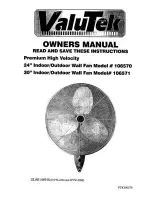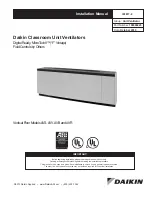
EN
| 5
206268 | A024
The fan motor has built in protection for locked
rotor, which implies that the motor tries to
restart with a preprogrammed interval
whenever it senses that the rotor is standing
still. When the blockage is removed the fan will
start up by itself without any further measures.
At high motor temperatures the current will be
cut from the motor. It can then only be
restarted by manually disconnecting the mains
supply to the fan for couple of minutes.
Transportation and Storage
All fans are packaged at the factory to withstand
normal transport handling. When handling the
goods use suitable lifting equipment in order to
avoid damage to fans and personnel. Do not lift
the fans by the connecting cable, connection
box, impeller or inlet cone. Avoid blows and
shock loads. Store the fans in a dry place
protected from weather and dirt until final
installation. Permissible storage temperatures -
40…+80°C.
Installation
Refer to Safety information above. Installation,
electrical connection and commissioning are
only to be carried out by authorised personnel
and in accordance with requirements and
demands. Fans with EC-motors must be
switched on/off via the control input.
Electrical connection according to the wiring
diagram in the terminal box, markings on
terminal blocks or on cable. Seal any empty
cable glands with dummy plugs. The K-EC fan
must be installed with the connection box at the
top of the unit ± 90 degrees. If permanent
installation is carried out using cables with
diameter 12-14 mm, the electrical gland must
be replaced (applies to type K-EC). Assemble the
fan in the direction of airflow (see arrow on
unit). The fan must be installed so that vibration
is not transmitted via ducted systems or
building structure. (Suitable accessories such as
fast clamps and diffusers are available). Make
sure the assembly of the fan is firm and stable.
The fan can be mounted in any direction unless
stated otherwise. The fans must be assembled
so that service and maintenance can be
performed easily and safely. Disturbing noise
can be avoided by installing silencers (available
accessory).
The fans are meant for continuous use within
the temperature range stated.
For fans which reset by cutting the current,
must be taken into consideration when
connecting surrounding equipment with
automatic on/off function.
EC motors have a leakage current to earth
corresponding to <=3,5 mA. This needs to be
considered whenever the fan is connected
together with an earth fault breaker.
Integral potentiometer
The integral potentiometer is factory preset
(Fig. 1-15). This value can be changed manually
to obtain a different motor rpm/fan
performance. Fan performance charts for this
purpose are shown in the table by voltage steps
on page 11-25 (Fig. 1-15) to the right of the pot.
symbols. An external potentiometer can be
connected if necessary. If so the internal
potentiometer needs to be disconnected from
the connection terminals.
Tach output
Terminal No. 1 in the wiring diagrams (white
signal cable) enables connection of an rpm
counter (one pulse per revolution), controller,
alarm or a speed display. The Tacho a signal
with max 10mA.
Operation
Before initial operation, check the following:
-
Electrical connection has been properly
completed.
-
Protective conductor has been connected.
-
Safety devices in place (protection grid)
-
Leftover installation materials and foreign
materials have been removed from the
casing.
When putting into operation, check the
following:
-
Connection data corresponds to the
specifications on the nameplate: Maximum
v6%, -10%, according to IEC 38. Rated
current must not be exceeded with more
than 5% at rated voltage.
-
Smoothness of motor operation, (no
abnormal noises).
-
Fans must only be operated by a person who
has suitable knowledge or education within
Summary of Contents for TFSK 160 EC
Page 1: ...K KV 125W Multilingual ...
Page 81: ... 81 206268 A024 TFSR TFSK EC ...
Page 82: ...82 206268 A024 KVK Slim 100 160 EC ...
Page 88: ...88 206268 A024 KV DUO EC For KV DUO 150 315 EC For KV DUO 400 EC For KV DUO 500 560 EC ...
Page 105: ......
Page 106: ......
Page 107: ......






































